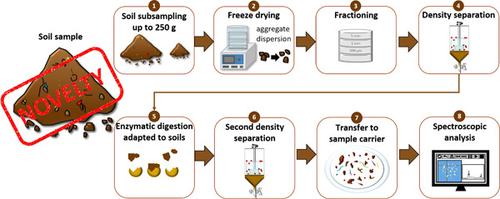当前位置:
X-MOL 学术
›
Environ. Toxicol. Chem.
›
论文详情
Our official English website, www.x-mol.net, welcomes your
feedback! (Note: you will need to create a separate account there.)
Tackling the Challenge of Extracting Microplastics from Soils: A Protocol to Purify Soil Samples for Spectroscopic Analysis
Environmental Toxicology and Chemistry ( IF 3.6 ) Pub Date : 2021-02-23 , DOI: 10.1002/etc.5024 Julia N Möller 1 , Ingrid Heisel 1 , Anna Satzger 1 , Eva C Vizsolyi 1 , S D Jakob Oster 1 , Seema Agarwal 2 , Christian Laforsch 1 , Martin G J Löder 1
Environmental Toxicology and Chemistry ( IF 3.6 ) Pub Date : 2021-02-23 , DOI: 10.1002/etc.5024 Julia N Möller 1 , Ingrid Heisel 1 , Anna Satzger 1 , Eva C Vizsolyi 1 , S D Jakob Oster 1 , Seema Agarwal 2 , Christian Laforsch 1 , Martin G J Löder 1
Affiliation

|
Microplastic pollution in soils is an emerging topic in the scientific community, with researchers striving to determine the occurrence and the impact of microplastics on soil health, ecology, and functionality. However, information on the microplastic contamination of soils is limited because of a lack of suitable analytical methods. Because micro-Fourier-transform infrared spectroscopy (µ-FTIR), next to Raman spectroscopy, is one of the few methods that allows the determination of the number, polymer type, shape, and size of microplastic particles, the present study addresses the challenge of purifying soil samples sufficiently to allow a subsequent µ-FTIR analysis. A combination of freeze-drying, sieving, density separation, and a sequential enzymatic-oxidative digestion protocol enables removal of the mineral mass (>99.9% dry wt) and an average reduction of 77% dry weight of the remaining organic fraction. In addition to visual integrity, attenuated total reflectance FTIR, gel permeation chromatography, and differential scanning calorimetry showed that polyamide, polyethylene, polyethylene terephthalate, and polyvinyl chloride in the size range of 100 to 400 µm were not affected by the approach. However, biodegradable polylactic acid showed visible signs of degradation and reduced molecular weight distribution after protease treatment. Nevertheless, the presented purification protocol is a reliable and robust method to purify relatively large soil samples of approximately 250 g dry weight for spectroscopic analysis in microplastic research and has been shown to recover various microplastic fibers and fragments down to a size of 10 µm from natural soil samples. Environ Toxicol Chem 2022;41:844–857. © 2021 The Authors. Environmental Toxicology and Chemistry published by Wiley Periodicals LLC on behalf of SETAC.
中文翻译:

应对从土壤中提取微塑料的挑战:净化土壤样品以进行光谱分析的协议
土壤中的微塑料污染是科学界的一个新兴话题,研究人员致力于确定微塑料的发生及其对土壤健康、生态和功能的影响。然而,由于缺乏合适的分析方法,有关土壤微塑料污染的信息有限。由于微傅里叶变换红外光谱 (µ-FTIR) 是仅次于拉曼光谱的少数几种能够确定微塑料颗粒的数量、聚合物类型、形状和大小的方法之一,因此本研究解决了这一挑战充分净化土壤样品以进行后续的 µ-FTIR 分析。冷冻干燥、筛分、密度分离和顺序酶氧化消化方案的组合能够去除矿物质质量 (>99. 9% 干重)和平均减少 77% 干重的剩余有机部分。除了视觉完整性之外,衰减全反射 FTIR、凝胶渗透色谱和差示扫描量热法表明,100 至 400 µm 尺寸范围内的聚酰胺、聚乙烯、聚对苯二甲酸乙二醇酯和聚氯乙烯不受该方法的影响。然而,可生物降解的聚乳酸在蛋白酶处理后显示出明显的降解迹象和降低的分子量分布。尽管如此,所提出的净化方案是一种可靠且稳健的方法,可净化约 250 g 干重的相对较大的土壤样品,用于微塑料研究中的光谱分析,并已证明可以从天然中回收各种微塑料纤维和碎片,其尺寸小至 10 µm土壤样品。除了视觉完整性之外,衰减全反射 FTIR、凝胶渗透色谱和差示扫描量热法表明,100 至 400 µm 尺寸范围内的聚酰胺、聚乙烯、聚对苯二甲酸乙二醇酯和聚氯乙烯不受该方法的影响。然而,可生物降解的聚乳酸在蛋白酶处理后显示出明显的降解迹象和降低的分子量分布。尽管如此,所提出的净化方案是一种可靠且稳健的方法,可净化约 250 g 干重的相对较大的土壤样品,用于微塑料研究中的光谱分析,并已证明可以从天然中回收各种微塑料纤维和碎片,其尺寸小至 10 µm土壤样品。除了视觉完整性之外,衰减全反射 FTIR、凝胶渗透色谱和差示扫描量热法表明,100 至 400 µm 尺寸范围内的聚酰胺、聚乙烯、聚对苯二甲酸乙二醇酯和聚氯乙烯不受该方法的影响。然而,可生物降解的聚乳酸在蛋白酶处理后显示出明显的降解迹象和降低的分子量分布。尽管如此,所提出的净化方案是一种可靠且稳健的方法,可净化约 250 g 干重的相对较大的土壤样品,用于微塑料研究中的光谱分析,并已证明可以从天然中回收各种微塑料纤维和碎片,其尺寸小至 10 µm土壤样品。和差示扫描量热法表明,100~400 µm尺寸范围内的聚酰胺、聚乙烯、聚对苯二甲酸乙二醇酯和聚氯乙烯不受该方法的影响。然而,可生物降解的聚乳酸在蛋白酶处理后显示出明显的降解迹象和降低的分子量分布。尽管如此,所提出的净化方案是一种可靠且稳健的方法,可净化约 250 g 干重的相对较大的土壤样品,用于微塑料研究中的光谱分析,并已证明可以从天然中回收各种微塑料纤维和碎片,其尺寸小至 10 µm土壤样品。和差示扫描量热法表明,100~400 µm尺寸范围内的聚酰胺、聚乙烯、聚对苯二甲酸乙二醇酯和聚氯乙烯不受该方法的影响。然而,可生物降解的聚乳酸在蛋白酶处理后显示出明显的降解迹象和降低的分子量分布。尽管如此,所提出的净化方案是一种可靠且稳健的方法,可净化约 250 g 干重的相对较大的土壤样品,用于微塑料研究中的光谱分析,并已证明可以从天然中回收各种微塑料纤维和碎片,其尺寸小至 10 µm土壤样品。可生物降解的聚乳酸在蛋白酶处理后显示出明显的降解迹象和分子量分布降低。尽管如此,所提出的净化方案是一种可靠且稳健的方法,可净化约 250 g 干重的相对较大的土壤样品,用于微塑料研究中的光谱分析,并已证明可以从天然中回收各种微塑料纤维和碎片,其尺寸小至 10 µm土壤样品。可生物降解的聚乳酸在蛋白酶处理后显示出明显的降解迹象和分子量分布降低。尽管如此,所提出的净化方案是一种可靠且稳健的方法,可净化约 250 g 干重的相对较大的土壤样品,用于微塑料研究中的光谱分析,并已证明可以从天然中回收各种微塑料纤维和碎片,其尺寸小至 10 µm土壤样品。环境毒物化学2022;41:844–857。© 2021 作者。Wiley Periodicals LLC 代表 SETAC 出版的Environmental Toxicology and Chemistry 。
更新日期:2021-02-23
中文翻译:

应对从土壤中提取微塑料的挑战:净化土壤样品以进行光谱分析的协议
土壤中的微塑料污染是科学界的一个新兴话题,研究人员致力于确定微塑料的发生及其对土壤健康、生态和功能的影响。然而,由于缺乏合适的分析方法,有关土壤微塑料污染的信息有限。由于微傅里叶变换红外光谱 (µ-FTIR) 是仅次于拉曼光谱的少数几种能够确定微塑料颗粒的数量、聚合物类型、形状和大小的方法之一,因此本研究解决了这一挑战充分净化土壤样品以进行后续的 µ-FTIR 分析。冷冻干燥、筛分、密度分离和顺序酶氧化消化方案的组合能够去除矿物质质量 (>99. 9% 干重)和平均减少 77% 干重的剩余有机部分。除了视觉完整性之外,衰减全反射 FTIR、凝胶渗透色谱和差示扫描量热法表明,100 至 400 µm 尺寸范围内的聚酰胺、聚乙烯、聚对苯二甲酸乙二醇酯和聚氯乙烯不受该方法的影响。然而,可生物降解的聚乳酸在蛋白酶处理后显示出明显的降解迹象和降低的分子量分布。尽管如此,所提出的净化方案是一种可靠且稳健的方法,可净化约 250 g 干重的相对较大的土壤样品,用于微塑料研究中的光谱分析,并已证明可以从天然中回收各种微塑料纤维和碎片,其尺寸小至 10 µm土壤样品。除了视觉完整性之外,衰减全反射 FTIR、凝胶渗透色谱和差示扫描量热法表明,100 至 400 µm 尺寸范围内的聚酰胺、聚乙烯、聚对苯二甲酸乙二醇酯和聚氯乙烯不受该方法的影响。然而,可生物降解的聚乳酸在蛋白酶处理后显示出明显的降解迹象和降低的分子量分布。尽管如此,所提出的净化方案是一种可靠且稳健的方法,可净化约 250 g 干重的相对较大的土壤样品,用于微塑料研究中的光谱分析,并已证明可以从天然中回收各种微塑料纤维和碎片,其尺寸小至 10 µm土壤样品。除了视觉完整性之外,衰减全反射 FTIR、凝胶渗透色谱和差示扫描量热法表明,100 至 400 µm 尺寸范围内的聚酰胺、聚乙烯、聚对苯二甲酸乙二醇酯和聚氯乙烯不受该方法的影响。然而,可生物降解的聚乳酸在蛋白酶处理后显示出明显的降解迹象和降低的分子量分布。尽管如此,所提出的净化方案是一种可靠且稳健的方法,可净化约 250 g 干重的相对较大的土壤样品,用于微塑料研究中的光谱分析,并已证明可以从天然中回收各种微塑料纤维和碎片,其尺寸小至 10 µm土壤样品。和差示扫描量热法表明,100~400 µm尺寸范围内的聚酰胺、聚乙烯、聚对苯二甲酸乙二醇酯和聚氯乙烯不受该方法的影响。然而,可生物降解的聚乳酸在蛋白酶处理后显示出明显的降解迹象和降低的分子量分布。尽管如此,所提出的净化方案是一种可靠且稳健的方法,可净化约 250 g 干重的相对较大的土壤样品,用于微塑料研究中的光谱分析,并已证明可以从天然中回收各种微塑料纤维和碎片,其尺寸小至 10 µm土壤样品。和差示扫描量热法表明,100~400 µm尺寸范围内的聚酰胺、聚乙烯、聚对苯二甲酸乙二醇酯和聚氯乙烯不受该方法的影响。然而,可生物降解的聚乳酸在蛋白酶处理后显示出明显的降解迹象和降低的分子量分布。尽管如此,所提出的净化方案是一种可靠且稳健的方法,可净化约 250 g 干重的相对较大的土壤样品,用于微塑料研究中的光谱分析,并已证明可以从天然中回收各种微塑料纤维和碎片,其尺寸小至 10 µm土壤样品。可生物降解的聚乳酸在蛋白酶处理后显示出明显的降解迹象和分子量分布降低。尽管如此,所提出的净化方案是一种可靠且稳健的方法,可净化约 250 g 干重的相对较大的土壤样品,用于微塑料研究中的光谱分析,并已证明可以从天然中回收各种微塑料纤维和碎片,其尺寸小至 10 µm土壤样品。可生物降解的聚乳酸在蛋白酶处理后显示出明显的降解迹象和分子量分布降低。尽管如此,所提出的净化方案是一种可靠且稳健的方法,可净化约 250 g 干重的相对较大的土壤样品,用于微塑料研究中的光谱分析,并已证明可以从天然中回收各种微塑料纤维和碎片,其尺寸小至 10 µm土壤样品。环境毒物化学2022;41:844–857。© 2021 作者。Wiley Periodicals LLC 代表 SETAC 出版的Environmental Toxicology and Chemistry 。











































 京公网安备 11010802027423号
京公网安备 11010802027423号